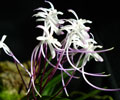|
|
|
|
|
| |
Flasks of
Neofinetia falcata var. Syutenno 'John's Sparky' AM/AOS × self |
|
| |
|
|
| |
| Number: |
TN4823 |
| Name: |
Neofinetia falcata var. Syutenno 'John's Sparky' AM/AOS × self
|
| Type: |
self (What's that?) |
|
Click to Enlarge

Pod Parent Flowers |
Click to Enlarge

Pod Parent Flowers |
Click to Enlarge

Pod Parent Blooming Plant |
|
|
|
| |
Culture Notes from Donor: Parent plant: Temperature range I (60-83°F)
Comments: Parent plant: Newly awarded Pink Neofinetia. The photos don't do the flowers justice! Hot pink tips on petals and sepals, hot pink spurs, panicle described as eggplant. This plant was awarded for it's exceptional color. Quite floriferous and temperature tolerant. Neofinetias can take temps down to 40°F in winter, up to 90°F in summer. The fragrance is one of the best in the orchid world-- described as vanilla, jasmine... I think they smell like shortbread cookies. Strong enough to scent an entire room... but not cloying or obnoxious. The spring flowers can last up to 2 months, they are quite substantial, with sparkly texture. Putting out 1 to 2 new growths per fan, they quickly reach specimen size... Very expensive to buy as mature plants... they are usually priced PER GROWTH! Neofinetias bloom as small plants and can be grown on the windowsill. Miniature.
For additional origin/habitat information supplied courtesy of
Charles and Margaret Baker, see further below, near the bottom of this page.
|
Temperatures we attempt to use in the lab & greenhouse:
| For Species: |
|
Spring, Summer, Autumn: days average 83°F, nights 70°F; best fit is Warm-Intermediate 87-64°F
(Source:
Baker's Web OSC) |
| For Species: |
|
Winter: days average 55°F, nights 39°F; best fit is Cold 58-38°F
(Source:
Baker's Web OSC) |
|
About the name...
| Etymology of |
falcata |
|
From Latin "falcatus" sickle-shaped, hooked.
(Source:
Brown 1956) |
| Etymology of |
Neofinetia |
|
From Greek "neos" new (for the 2nd genus); in honor of M. Achille Finet.
(Source:
Pridgeon 1992) |
| Pronunciation of |
falcata |
|
fal-KAH-ta
(Source:
Hawkes 1978) |
| Pronunciation of |
Neofinetia |
|
nee-oh-fi-NET-ee-ah
(Source:
Pridgeon 1992) |
|
If you would like to direct someone to this web page, please copy and paste this URL into your email:
http://troymeyers.com/d?014823
| Flask Information |
| Availability: |
We have sold all of the flasks for this item. |
| You should: |
Consider getting individual plants or compots instead of a flask.
You can place a "Notify Flask Recipients" Request, and either we or a flask recipient may contact you when plants are available.
You may also place a "Notify Retries" Request, and if an identical pollination (the same parents) is done again, we'll let you know.
You may reserve a flask, but it's very unlikely you'll get one ...this could only happen if we found a flask that we didn't know we had. |
| Yield Estimate: |
270 plants (based on flask surveys done 10/27/2006 through 07/01/2009)
|
| Plantlet Sizes: |
From many flasks 6 - 60 mm plants (based on flask surveys done 10/27/2006 through 08/23/2010)
From one most recently surveyed flask 20 - 50 mm (08/23/2010)
|
|
You might also want to:
|
View the seed assay for this item.
View items of the same species.
View items of the same genus.
|
| Ordering Information |
| You are not currently logged in. |
|
You must be a registered user and be logged in to reserve a flask or place a notification request. Please log in:
|
|
|
|
|
|
| |
The origin/habitat information below is supplied courtesy of Charles and Margaret Baker
The following information is based on the name of the plant provided by the donor, and assumes that the name is correct. If the plant has been misidentified, then the following information may not be correct.
This text is copyrighted by the Bakers and may not be reproduced without permission.
ORIGIN/HABITAT: Northeast Asia. Originally detected by Thunberg in
southern Japan, plants were growing on hills hear the port city of
Nagasaki on Kyushu Island. It is now known to be more widespread in Japan
where it grows on the islands of Honshu, Shikoku, and Kyushu. Plants are
also found on the small islands of Yakusima and Tanegasima off the
southern coast of Kyushu, on Okinawa in the Ryukyu Islands, and in China
and Korea. N. falcata may grow on rocks, but is usually found growing
epiphytically on rather small branches of deciduous trees where strong
light is received in winter and early spring. Plants normally grow at an
angle on the branch so that water drains away and does not collect at the
base of the leaves. A grower in Japan reported that N. falcata does well
mounted on the coarse bark of a persimmon tree in his garden in Yokohama.
More about this information and the Bakers...
|
|
|
| |
|
|
|